Amazon River
- 格式:ppt
- 大小:905.00 KB
- 文档页数:5
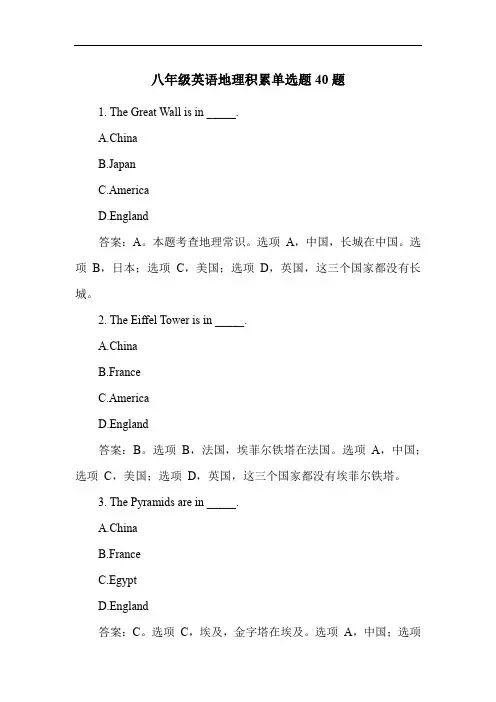
八年级英语地理积累单选题40题1. The Great Wall is in _____.A.ChinaB.JapanC.AmericaD.England答案:A。
本题考查地理常识。
选项A,中国,长城在中国。
选项B,日本;选项C,美国;选项D,英国,这三个国家都没有长城。
2. The Eiffel Tower is in _____.A.ChinaB.FranceC.AmericaD.England答案:B。
选项B,法国,埃菲尔铁塔在法国。
选项A,中国;选项C,美国;选项D,英国,这三个国家都没有埃菲尔铁塔。
3. The Pyramids are in _____.A.ChinaB.FranceC.EgyptD.England答案:C。
选项C,埃及,金字塔在埃及。
选项A,中国;选项B,法国;选项D,英国,这三个国家都没有金字塔。
4. The Statue of Liberty is in _____.A.ChinaB.FranceC.AmericaD.England答案:C。
选项C,美国,自由女神像在美国。
选项A,中国;选项B,法国;选项D,英国,这三个国家都没有自由女神像。
5. The Sydney Opera House is in _____.A.ChinaB.FranceC.AustraliaD.England答案:C。
选项C,澳大利亚,悉尼歌剧院在澳大利亚。
选项A,中国;选项B,法国;选项D,英国,这三个国家都没有悉尼歌剧院。
6.The water in the river ______ slowly.A.flowsB.runsC.jumpsD.falls答案:A。
本题考查动词辨析。
“flows”表示“流动”,符合河流中水的状态;“runs”通常表示人或动物跑;“jumps”是跳跃;“falls”是落下,都不符合河流中水的动作。
7.The clouds ______ across the sky.A.moveB.flyC.runD.walk答案:A。
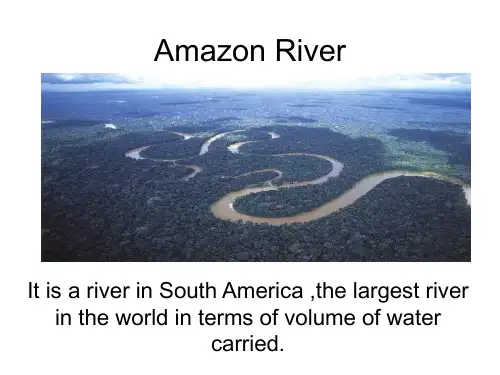
Amazon RiverIt is a river in South America ,the largest river in the world in terms of volume of watercarried.It is one of the longest rivers in the world, approximately 6,276 km (3,900 miles) long ,which only shorter than the Nile River (approximately 6,671 km long), And the width is 190 km.Contents1 Drainage area2 Origins3 Flooding4 Geography5 Mouth6 Wildlife7Dispute regarding length争端有关长度8Major tributaries 主要支流9References1 Drainage area流域面积•The Amazon Basin, the largest in the world, covers about 30% of South America, an area of approximately 7050.000 square kilometres (2.7 sq mi). It flows from west to east from Iquitos in Peru(秘鲁的伊基托斯)to all the way across Brazil to the Atlantic.2 Origins•The Amazon originatesfrom the Apacheta cliffin Arequipa(阿雷基帕悬崖)at the NevadoMismi , marked only bya wooden cross.A NASA satellite image of a flooded portion of the river NASA的卫星图像显示的河水淹没的部分。
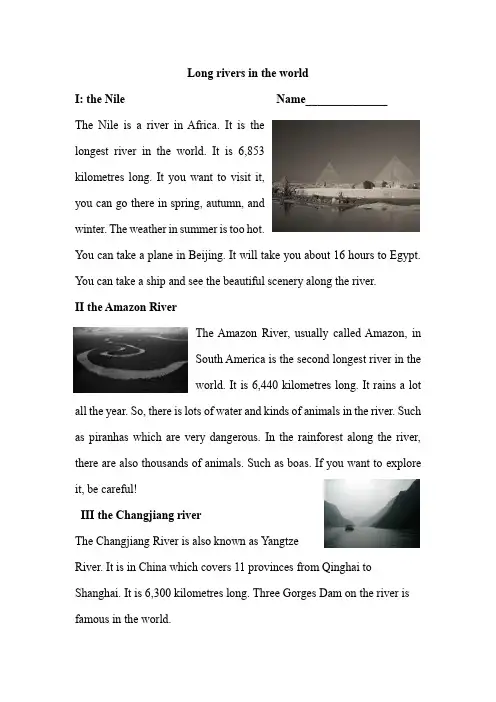
Long rivers in the worldI: the Nile Name______________The Nile is a river in Africa. It is the longest river in the world. It is 6,853 kilometreslong. It you want to visit it, you can go there in spring, autumn, and winter. The weather in summer is too hot. You can take a plane in Beijing. It will take you about 16 hours to Egypt. You can take a ship and see the beautiful scenery along the river.II the Amazon RiverThe Amazon River, usually called Amazon, in South America is the second longest river in the world. It is 6,440kilometreslong. It rains a lot all the year. So,there is lots of water and kinds of animals in the river. Such as piranhas which are very dangerous. In the rainforest along the river, there are also thousands of animals. Such as boas. If you want to explore it, be careful!III the Changjiang riverTheChangjiangRiver is also known asYangtze River. It is in China which covers 11 provinces from Qinghai to Shanghai. It is 6,300 kilometres long. Three Gorges Dam on the river is famous in the world.一:读短文,完成下列表格。

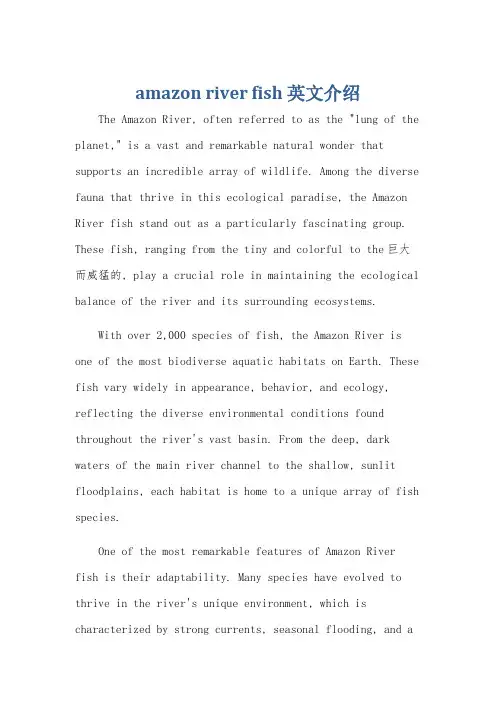
amazon river fish 英文介绍The Amazon River, often referred to as the "lung of the planet," is a vast and remarkable natural wonder that supports an incredible array of wildlife. Among the diverse fauna that thrive in this ecological paradise, the Amazon River fish stand out as a particularly fascinating group. These fish, ranging from the tiny and colorful to the巨大而威猛的, play a crucial role in maintaining the ecological balance of the river and its surrounding ecosystems.With over 2,000 species of fish, the Amazon River is one of the most biodiverse aquatic habitats on Earth. These fish vary widely in appearance, behavior, and ecology, reflecting the diverse environmental conditions found throughout the river's vast basin. From the deep, dark waters of the main river channel to the shallow, sunlit floodplains, each habitat is home to a unique array of fish species.One of the most remarkable features of Amazon Riverfish is their adaptability. Many species have evolved to thrive in the river's unique environment, which is characterized by strong currents, seasonal flooding, and awide range of water temperatures. For example, some fish have developed flat bodies and enlarged fins to help them navigate the fast-moving waters, while others have evolved to burrow into the riverbed mud during the dry season.The ecological importance of Amazon River fish cannot be overstated. As predators, prey, and competitors, they play crucial roles in maintaining the balance of theriver's food web. They also serve as important indicators of the overall health of the ecosystem. Changes in fish populations can provide early warnings of environmental degradation or pollution, allowing for timely interventions to protect the river's biodiversity.Unfortunately, the Amazon River and its fish face numerous threats today. Deforestation, illegal fishing, and pollution from agricultural runoff and mining operations have all taken a heavy toll on the river's ecosystem. These activities have led to the decline of many fish species, some to the brink of extinction.To protect the Amazon River fish and their habitats, it is crucial to address the underlying causes of these threats. This includes promoting sustainable land usepractices, strengthening fishery management regulations, and improving water quality throughout the river's basin. International cooperation is also essential to address the transboundary issues that affect the Amazon River and its fish.In conclusion, the Amazon River fish are a remarkable testament to the biodiversity and ecological complexity of the Amazon River ecosystem. They play crucial roles in maintaining the health and balance of this vital natural resource, and their protection is essential for the well-being of the planet. By working together to address the threats they face, we can ensure that these remarkable fish and their habitats will continue to thrive for generations to come.**亚马逊河鱼类:独特的生物多样性**亚马逊河,常被称为“地球之肺”,是一个广阔而令人惊叹的自然奇观,支持着令人难以置信的野生动植物群。
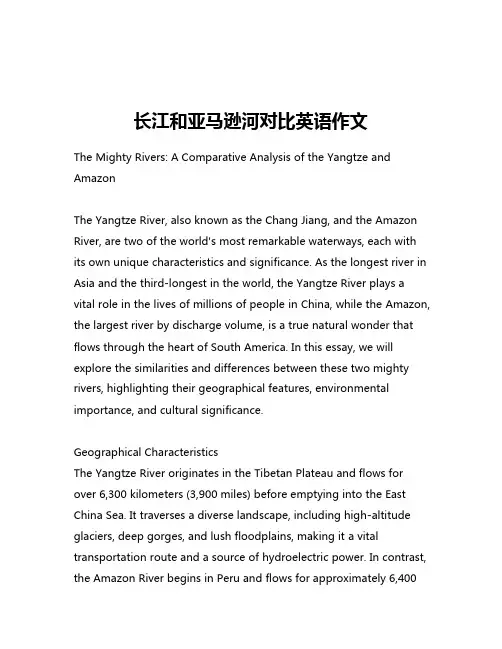
长江和亚马逊河对比英语作文The Mighty Rivers: A Comparative Analysis of the Yangtze and AmazonThe Yangtze River, also known as the Chang Jiang, and the Amazon River, are two of the world's most remarkable waterways, each with its own unique characteristics and significance. As the longest river in Asia and the third-longest in the world, the Yangtze River plays a vital role in the lives of millions of people in China, while the Amazon, the largest river by discharge volume, is a true natural wonder that flows through the heart of South America. In this essay, we will explore the similarities and differences between these two mighty rivers, highlighting their geographical features, environmental importance, and cultural significance.Geographical CharacteristicsThe Yangtze River originates in the Tibetan Plateau and flows for over 6,300 kilometers (3,900 miles) before emptying into the East China Sea. It traverses a diverse landscape, including high-altitude glaciers, deep gorges, and lush floodplains, making it a vital transportation route and a source of hydroelectric power. In contrast, the Amazon River begins in Peru and flows for approximately 6,400kilometers (4,000 miles) before reaching the Atlantic Ocean. It is known for its vast and complex drainage basin, which covers an area of over 7 million square kilometers (2.7 million square miles), making it the largest river basin in the world.One of the most striking differences between the two rivers is their width and depth. The Yangtze River, while impressive in its length, is relatively narrow, with an average width of around 1 kilometer (0.6 miles). In contrast, the Amazon River can be up to 40 kilometers (25 miles) wide during the rainy season, with an average depth of 40 meters (130 feet). This vast expanse of water, combined with the river's numerous tributaries, makes the Amazon one of the most impressive and awe-inspiring waterways on the planet.Environmental SignificanceBoth the Yangtze and the Amazon are home to an incredibly diverse array of plant and animal life, making them crucial to the ecological balance of their respective regions. The Yangtze River basin is home to over 140 species of fish, including the iconic Chinese sturgeon and the endangered Yangtze finless porpoise. The river also supports a rich wetland ecosystem, providing vital habitat for migratory birds and other wildlife.The Amazon, on the other hand, is renowned for its unparalleled biodiversity. The river and its tributaries are home to an estimated2,500 species of fish, as well as countless species of mammals, birds, reptiles, and insects. The Amazon rainforest, which covers much of the river's basin, is the largest and most diverse tropical rainforest in the world, and is often referred to as the "lungs of the planet" for its crucial role in regulating global climate and air quality.Both rivers face significant environmental challenges, however. The Yangtze River has been heavily impacted by human activities, including the construction of the Three Gorges Dam, which has altered the river's natural flow and disrupted the delicate ecosystem. Similarly, the Amazon rainforest is under threat from deforestation, mining, and other forms of human-induced environmental degradation.Cultural SignificanceThe Yangtze and Amazon rivers have played a vital role in the cultural and economic development of the regions they flow through. In China, the Yangtze River has been a hub of civilization for thousands of years, with cities and towns lining its banks and serving as important centers of trade, commerce, and transportation. The river has also been the subject of countless works of art, literature, and poetry, and is deeply embedded in Chinese culture and tradition.The Amazon River, on the other hand, has long been a source of fascination and wonder for people around the world. The river andits surrounding rainforest have been home to indigenous communities for millennia, who have developed a deep respect and understanding of the river's importance to their way of life. The Amazon has also inspired countless explorers, scientists, and adventurers, who have sought to uncover its many secrets and understand its role in the global ecosystem.Despite their geographical distance and cultural differences, the Yangtze and Amazon rivers share a common thread – their immense power and importance to the communities they serve. Both rivers are vital sources of freshwater, food, and transportation, and play a crucial role in shaping the lives and livelihoods of millions of people. As we face the challenges of climate change and environmental degradation, it is more important than ever to protect and preserve these remarkable natural wonders, ensuring that they continue to thrive and support the communities that depend on them.。
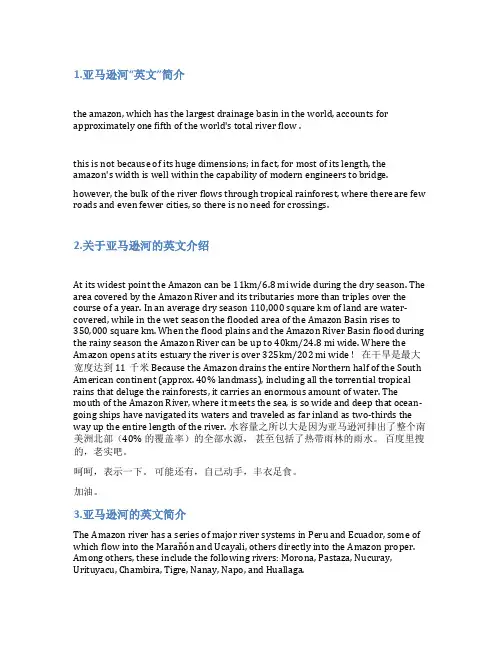
1.亚马逊河“英文”简介the amazon, which has the largest drainage basin in the world, accounts for approximately one fifth of the world's total river flow .this is not because of its huge dimensions; in fact, for most of its length, the amazon's width is well within the capability of modern engineers to bridge. however, the bulk of the river flows through tropical rainforest, where there are few roads and even fewer cities, so there is no need for crossings.2.关于亚马逊河的英文介绍At its widest point the Amazon can be 11km/6.8 mi wide during the dry season. The area covered by the Amazon River and its tributaries more than triples over the course of a year. In an average dry season 110,000 square km of land are water-covered, while in the wet season the flooded area of the Amazon Basin rises to 350,000 square km. When the flood plains and the Amazon River Basin flood during the rainy season the Amazon River can be up to 40km/24.8 mi wide. Where the Amazon opens at its estuary the river is over 325km/202 mi wide!在干旱是最大宽度达到11千米 Because the Amazon drains the entire Northern half of the South American continent (approx. 40% landmass), including all the torrential tropical rains that deluge the rainforests, it carries an enormous amount of water. The mouth of the Amazon River, where it meets the sea, is so wide and deep that ocean-going ships have navigated its waters and traveled as far inland as two-thirds the way up the entire length of the river. 水容量之所以大是因为亚马逊河排出了整个南美洲北部(40% 的覆盖率)的全部水源,甚至包括了热带雨林的雨水。
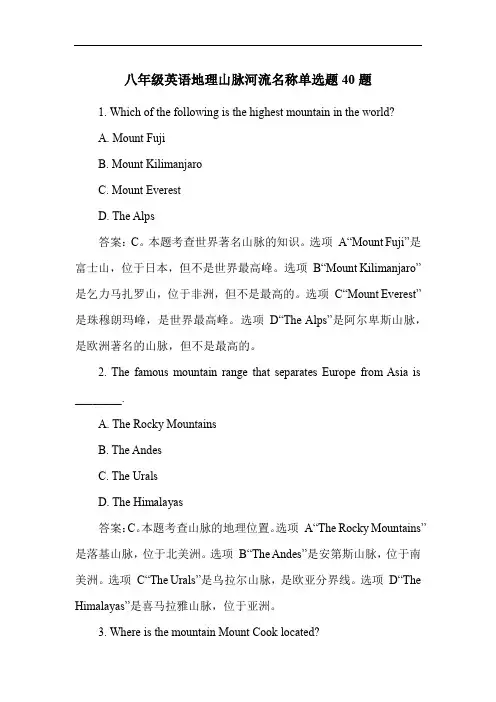
八年级英语地理山脉河流名称单选题40题1. Which of the following is the highest mountain in the world?A. Mount FujiB. Mount KilimanjaroC. Mount EverestD. The Alps答案:C。
本题考查世界著名山脉的知识。
选项A“Mount Fuji”是富士山,位于日本,但不是世界最高峰。
选项B“Mount Kilimanjaro”是乞力马扎罗山,位于非洲,但不是最高的。
选项C“Mount Everest”是珠穆朗玛峰,是世界最高峰。
选项D“The Alps”是阿尔卑斯山脉,是欧洲著名的山脉,但不是最高的。
2. The famous mountain range that separates Europe from Asia is ________.A. The Rocky MountainsB. The AndesC. The UralsD. The Himalayas答案:C。
本题考查山脉的地理位置。
选项A“The Rocky Mountains”是落基山脉,位于北美洲。
选项B“The Andes”是安第斯山脉,位于南美洲。
选项C“The Urals”是乌拉尔山脉,是欧亚分界线。
选项D“The Himalayas”是喜马拉雅山脉,位于亚洲。
3. Where is the mountain Mount Cook located?A. In AustraliaB. In New ZealandC. In CanadaD. In the United States答案:B。
本题考查山脉的所在国家。
选项 A 澳大利亚没有Mount Cook 这座山。
选项C 加拿大没有Mount Cook 这座山。
选项D 美国没有Mount Cook 这座山。
Mount Cook 位于新西兰。
4. Which mountain is known as the 'Roof of the World'?A. The Appalachian MountainsB. The Atlas MountainsC. The Pamir MountainsD. The Karakoram Mountains答案:C。

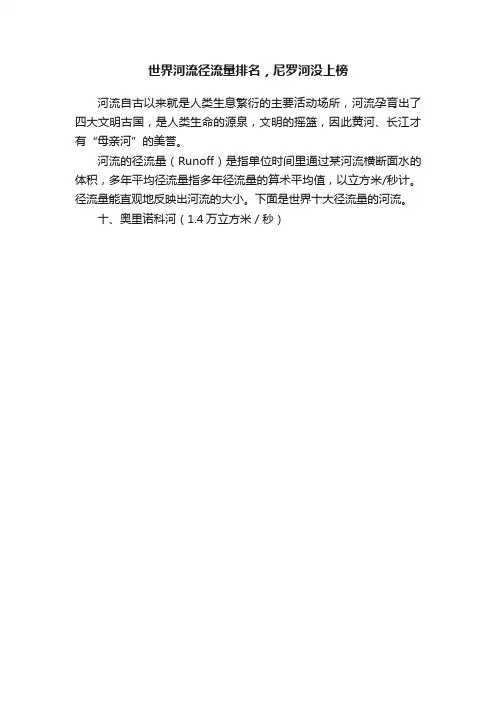
世界河流径流量排名,尼罗河没上榜河流自古以来就是人类生息繁衍的主要活动场所,河流孕育出了四大文明古国,是人类生命的源泉,文明的摇篮,因此黄河、长江才有“母亲河”的美誉。
河流的径流量(Runoff)是指单位时间里通过某河流横断面水的体积,多年平均径流量指多年径流量的算术平均值,以立方米/秒计。
径流量能直观地反映出河流的大小。
下面是世界十大径流量的河流。
十、奥里诺科河(1.4万立方米/秒)奥里诺科河(Orinoco River)是南美洲的重要河流,水量丰沛,支流众多,达436条,属南美洲四大水系之一。
奥里诺科河发源于委内瑞拉与巴西交界处,呈弧形绕行于圭亚那高原边缘,最后向东注入大西洋,全长2735千米,流域面积95万平方千米,河口平均流量达1.4万立方米/秒,最大流量3万立方米/秒。
流域范围包括委内瑞拉约4/5的地区和哥伦比亚1/4的地区。
整个河道约300千米的长度是委内瑞拉和哥伦比亚的国界界河,其余大部分都在委内瑞拉境内。
九、湄公河(1.5万立方米/秒)湄公河(Mekong River),发源于中国唐古拉山的东北坡,在中国境内叫澜沧江,流入中南半岛后的河段称为湄公河。
因由越南流出南海有9个出海口,故越南称之为九龙江。
湄公河全长4909千米,流域面积81.1万平方千米,是世界第七长河,东南亚第一大河,同时也是亚洲最重要的跨国水系,流经中国、老挝、缅甸、泰国、柬埔寨和越南。
河流沿岸的胡志明市、万象、金边三座大城市,均为越南、老挝、柬埔寨的最大城市,由此可见湄公河在中南半岛的重要作用。
湄公河平均流量每秒2140立方米,河口三角洲平均流量1.5万立方米/秒,虽然水量充沛,但随季节性变化很大,主干流又有不少激流及瀑布,造成湄公河的航运能力差,目前湄公河只有下游550千米可通航。
八、勒拿河(1.7万立方米/秒)勒拿河(Lena River)位于俄罗斯西伯利亚境内,发源于贝加尔湖西岸,流往北冰洋,全长4400千米,流域面积为249万平方千米,是世界第九长河。
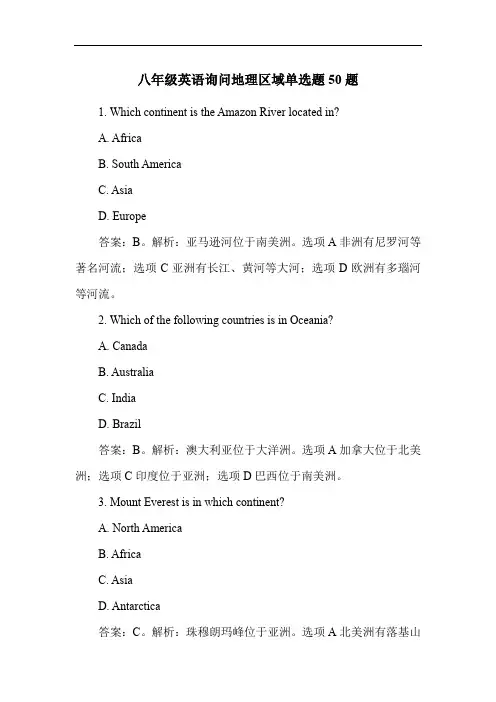
八年级英语询问地理区域单选题50题1. Which continent is the Amazon River located in?A. AfricaB. South AmericaC. AsiaD. Europe答案:B。
解析:亚马逊河位于南美洲。
选项A非洲有尼罗河等著名河流;选项C亚洲有长江、黄河等大河;选项D欧洲有多瑙河等河流。
2. Which of the following countries is in Oceania?A. CanadaB. AustraliaC. IndiaD. Brazil答案:B。
解析:澳大利亚位于大洋洲。
选项A加拿大位于北美洲;选项C印度位于亚洲;选项D巴西位于南美洲。
3. Mount Everest is in which continent?A. North AmericaB. AfricaC. AsiaD. Antarctica答案:C。
解析:珠穆朗玛峰位于亚洲。
选项A北美洲有落基山脉等;选项B非洲有乞力马扎罗山;选项D南极洲有文森峰等。
4. Which country in Europe has the Alps?A. ItalyB. ChinaC. EgyptD. Mexico答案:A。
解析:意大利是欧洲国家且境内有阿尔卑斯山。
选项B中国位于亚洲;选项C埃及位于非洲;选项D墨西哥位于北美洲。
5. The Mississippi River is in which continent?A. AfricaB. AsiaC. North AmericaD. South America答案:C。
解析:密西西比河位于北美洲。
选项A非洲有刚果河等;选项B亚洲河流众多但密西西比河不在亚洲;选项D南美洲有亚马逊河等。
6. Which of the following is a country in Africa?A. JapanB. KenyaC. AustraliaD. Canada答案:B。
长江和亚马逊河对比英语作文The Yangtze River and the Amazon River are two of the world's most iconic and significant rivers, each with its own unique characteristics and importance. Let's delve into a comparison between these two mighty waterways.The Yangtze River, the longest river in Asia and the third-longest in the world, is a vital lifeline for China. It flows through diverse landscapes, from the towering mountains of the Tibetan Plateau to the bustling metropolises of Shanghai and Chongqing. The Yangtze River Basin is home to a rich biodiversity and has played a crucial role in shaping Chinese history and culture.On the other hand, the Amazon River is the largest river by discharge volume in the world and flows through the heart of the Amazon rainforest, the most biodiverse ecosystem on the planet. The Amazon River basin is home to an incredible array of plant and animal species, many of which are found nowhere else on Earth. The river serves as a critical source of water and transportation for the region's indigenous communities and plays a vital role in regulating the global climate.While the Yangtze River is known for its culturalsignificance and historical importance, the Amazon River is renowned for its ecological richness and environmental importance. Both rivers face challenges such as pollution, deforestation, and habitat loss, highlighting the need for sustainable management and conservation efforts.In conclusion, the Yangtze River and the Amazon River are both remarkable natural wonders that have shaped the landscapes, cultures, and ecosystems of their respective regions. By understanding and appreciating the unique characteristics of these rivers, we can better appreciate the importance of preserving and protecting these vital waterways for future generations.中文翻译:长江和亚马逊河是世界上最具标志性和重要性的两条河流,各自具有独特的特点和重要性。
哪条河流是世界流程最长哪条河流是世界流程最长全球上有很多各式各样的河流,那么大家知道流程最长的河流具体是哪一条吗?长度分别是多少公里,分布在那个国家地区?以下是店铺帮大家整理的哪条河流是世界流程最长,欢迎大家借鉴与参考,希望对大家有所帮助。
世界流程最长的河流:尼罗河尼罗河,非洲主河流之父,位于非洲东北部,是一条国际河流,全长6670公里,是世界上最长的河流。
与中非地区的刚果河以及西非地区的尼日尔河并列非洲最大的三个河流系统。
尼罗河发源于东非高原上的布隆迪高地,有两条主要的支流,白尼罗河和青尼罗河。
干流流经布隆迪、卢旺达、坦桑尼亚、乌干达、苏丹和埃及等国,最后注入地中海。
从古代开始埃及的文明就依靠尼罗河而形成和兴旺,几乎所有的古埃及遗址均位于尼罗河畔。
尼罗河在印第安人语言叫月亮的眼泪。
尼罗河的流域地貌尼罗河流域南起东非高原,北抵地中海岸,东倚埃塞俄比亚高原,并沿红海向西北延伸,西邻刚果盆地、乍得盆地并沿马腊山脉、大吉勒夫高原和利比亚沙漠向北延伸。
流域地貌可简单归结为:主要由结晶岩组成的东非高原和由熔岩构成的埃塞俄比亚高原分别踞于流域的南侧和东南侧;整个苏丹基本上是一个由南往北微缓倾斜的巨大构造盆地,尼罗河纵贯其间;喀土穆以下尼罗河东西两侧则为广阔的沙漠台地。
(1)上游段:河源至维多利亚湖出口的河源段具有明显的山地河流特征,维多利亚湖出口至尼穆莱,河床比降达1:1200,沿途有卡巴雷加瀑布。
该河段流经地区除了维多利亚湖、基奥加湖等裂谷间的高原浅水湖泊,还有沿西支裂谷发育的蒙博托湖、爱德华湖和乔治湖等断层湖泊。
(2)中游段:尼罗河流经广阔的苏丹粘土平原,地势平坦,比降极缓,马拉卡勒以上比降只有1:13900,沿途沼泽密布,河道分汊漫流。
从马拉卡勒至喀土穆,河床比降更趋平缓,仅1:100000。
(3)下游段:尼罗河下游河段可细分为,①喀土穆至阿斯旺的峡谷段,尼罗河切穿广袤的沙漠谷地,奔流而下,比降1:6000。
亚马孙热带雨林简介英语作文The Amazon rainforest is a vast and diverse ecosystem that covers a significant portion of South America. Spanning across nine countries, this tropical wonder is home to an incredible array of plant and animal life, making it one of the most biodiverse regions on the planet. As the largest remaining tropical rainforest in the world, the Amazon plays a vital role in regulating the global climate and supporting the livelihoods of millions of people.At the heart of the Amazon basin lies the mighty Amazon River, the second-longest river in the world after the Nile. Originating in Peru, the Amazon and its tributaries wind their way through the rainforest, creating a vast network of waterways that are essential to the region's ecology and economy. The river is teeming with a diverse array of aquatic life, including the iconic Amazon river dolphin, the giant river otter, and the massive arapaima fish.The Amazon rainforest is renowned for its incredible biodiversity, with an estimated 390 billion trees and 2.5 million different species of insects. This vast ecosystem is home to a staggering array of plantand animal life, including many species that are yet to be discovered. From the towering canopy of the rainforest to the dark, damp forest floor, every inch of the Amazon is teeming with life.One of the most remarkable aspects of the Amazon rainforest is the incredible diversity of its plant life. The region is home to an estimated 40,000 different species of plants, many of which have not yet been catalogued by scientists. These plants play a vital role in the ecosystem, providing food and shelter for a wide range of animals, as well as regulating the climate and water cycle.Among the most iconic plant species found in the Amazon is the Brazil nut tree. These massive trees can grow up to 150 feet tall and produce a bounty of nutritious nuts that have been a staple food for indigenous communities for centuries. Other notable plant species include the cacao tree, which produces the raw material for chocolate, and the rubber tree, which was once the primary source of natural rubber.The Amazon rainforest is also home to an incredible diversity of animal life, including many species that are found nowhere else on Earth. From the majestic jaguar to the elusive giant anteater, the region is teeming with a wide range of mammals, birds, reptiles, and amphibians. Some of the most iconic animal species found in the Amazon include the red-eyed tree frog, the harpy eagle, and theanaconda, the largest snake in the world.One of the most pressing threats to the Amazon rainforest is deforestation, which is occurring at an alarming rate due to a variety of human activities. Logging, mining, agriculture, and infrastructure development have all contributed to the destruction of this vital ecosystem, with an estimated 17% of the original Amazon rainforest already lost.The impact of deforestation on the Amazon rainforest is far-reaching, with consequences that extend far beyond the borders of the region. The loss of trees and vegetation can lead to a decline in biodiversity, the release of stored carbon into the atmosphere, and the disruption of local and global weather patterns. Additionally, the displacement of indigenous communities and the loss of traditional knowledge and practices can have devastating social and cultural impacts.In recent years, there have been growing efforts to protect and preserve the Amazon rainforest, both at the local and global level. Many countries within the Amazon basin have implemented policies and programs aimed at reducing deforestation and promoting sustainable development. Additionally, international organizations and environmental groups have worked tirelessly to raise awareness about the importance of the Amazon and the need to protect it.One of the most promising initiatives to emerge in recent years is the REDD+ (Reducing Emissions from Deforestation and Forest Degradation) program, which provides financial incentives to countries and communities that work to conserve their forests. By placing a monetary value on the ecosystem services provided by the Amazon rainforest, REDD+ aims to create a market-based solution to the problem of deforestation.Another important initiative is the creation of protected areas and indigenous reserves within the Amazon basin. These designated areas, which are managed by local communities or government agencies, help to safeguard the region's biodiversity and ensure that indigenous peoples can continue to practice their traditional ways of life.Despite these efforts, the future of the Amazon rainforest remains uncertain. Climate change, coupled with ongoing deforestation and development pressures, pose a significant threat to the region's delicate ecosystem. As the world's attention turns to the urgency of addressing the global climate crisis, the Amazon rainforest has become a crucial battleground in the fight to preserve our planet's most precious natural resources.In conclusion, the Amazon rainforest is a truly remarkable and irreplaceable natural wonder. Its vast expanse of biodiversity, its rolein regulating the global climate, and its importance to the livelihoods of millions of people make it a vital resource that must be protected for generations to come. While the challenges facing the Amazon are significant, there is still time to take action and ensure that this unique and precious ecosystem endures.。
六年级英语地理知识单选题40题1. This city is known as the "Big Apple".A. LondonB. ParisC. New YorkD. Tokyo答案:C。
“Big Apple”是纽约的别称。
伦敦是英国首都,有“雾都”等别称;巴黎是法国首都,有“浪漫之都”等别称;东京是日本首都。
2. The city where the Eiffel Tower is located.A. RomeB. BerlinC. ParisD. Madrid答案:C。
埃菲尔铁塔在巴黎。
罗马有古罗马斗兽场等著名景点;柏林有柏林墙等景点;马德里是西班牙首都。
3. This city is famous for the Statue of Liberty.A. SydneyB. TorontoC. New YorkD. Moscow答案:C。
自由女神像在纽约。
悉尼有悉尼歌剧院;多伦多是加拿大城市;莫斯科是俄罗斯首都。
4. The city that has the Tower Bridge.A. LondonB. ViennaC. StockholmD. Amsterdam答案:A。
塔桥在伦敦。
维也纳是奥地利首都;斯德哥尔摩是瑞典首都;阿姆斯特丹是荷兰首都。
5. The city where the Opera House is located.A. New DelhiB. SydneyC. CairoD. Bangkok答案:B。
悉尼歌剧院在悉尼。
新德里是印度首都;开罗是埃及首都;曼谷是泰国首都。
6. This city is known as the capital of Japan.A. SeoulB. BeijingC. TokyoD. Manila答案:C。
东京是日本首都。
首尔是韩国首都;北京是中国首都;马尼拉是菲律宾首都。
7. The city that has the Brandenburg Gate.A. BerlinB. PragueC. BudapestD. Warsaw答案:A。
地理英语词汇练习30题1. There is a long ______ in this area.A. mountainB. riverC. lakeD. forest答案:B。
本题主要考查地理名词的辨析。
选项A“mountain”意思是“山脉”,通常指高大的山体;选项B“river”意思是“河流”,符合“long”( 长的)这一描述;选项C“lake”意思是“湖泊”;选项D“forest”意思是“森林”。
题干说“在这个地区有一个长的......”,根据常识和描述,长的通常是河流,所以选择B。
2. The ______ is very wide.A. seaB. oceanC. riverD. stream答案:A。
本题考查不同水域的名词。
选项A“sea”意思是“海”,相对较小;选项B“ocean”意思是“海洋”,范围更广;选项C“river”意思是“河流”;选项D“stream”意思是“小溪”。
题干说“......非常宽”,海相对海洋较小,但比河流和小溪宽,所以选择A。
3. We can see many high ______ in the picture.A. mountainsB. hillsC. desertsD. plains答案:A。
此题考查山脉相关的名词。
选项A“mountains”意思是“山脉”,通常高大且连绵;选项B“hills”意思是“小山丘”,高度相对较低;选项C“deserts”意思是“沙漠”;选项D“plains”意思是“平原”。
题干说“在图片中我们能看到许多高的......”,结合“high” 高的)和“many” 许多),应该是高大且连绵的山脉,所以选A。
4. The water in the ______ is very clear.A. riverB. lakeC. seaD. ocean答案:B。
本题考查不同水体的特点。
选项A“river”意思是“河流”,水流通常较快;选项B“lake”意思是“湖泊”,水相对平静且可能更清澈;选项C“sea”意思是“海”;选项D“ocean”意思是“海洋”。
亚马孙河简介1. 亚马孙河概述亚马孙河(Amazon River)是南美洲最长、最宽的河流,也是世界上水量最大的河流之一。
它位于南美洲东北部,源头位于秘鲁安第斯山脉的马拉尼昂山,全长约6,400公里,流经秘鲁、哥伦比亚和巴西三个国家,最终注入大西洋。
亚马孙河流域的面积约为7,062,000平方公里,占南美洲陆地面积的约40%。
2. 地理特征亚马孙河的流域地势复杂,涵盖了各种地形,包括高山、丘陵、平原和雨林。
河流沿途有大量的支流和支流河口,其中一些支流的长度甚至超过了其他国家的主要河流。
亚马孙河流域的气候主要分为热带雨林气候和热带季风气候。
年降水量非常丰富,平均每年超过2,000毫米。
由于降雨量多,河流的水位变化很大,干季时水位较低,雨季时水位上涨迅速,有时还会引发洪水。
3. 生物多样性亚马孙河流域是地球上生物多样性最丰富的地区之一。
它是世界上最大的热带雨林之一,被誉为“地球之肺”。
这里栖息着众多珍稀的动植物物种,其中许多是独一无二的。
河流和河流周围的湿地是许多物种的栖息地,包括豹、美洲狮、巴西龟和粉红河豚等。
亚马孙河还是世界上最大的淡水鱼类产卵地之一,每年吸引大量的鱼类迁徙到这里。
4. 对人类的重要性亚马孙河对人类具有重要的经济和生活意义。
河流流域的土壤肥沃,适宜农业开发。
这里种植着许多重要的农作物,如咖啡、可可、香蕉和木材。
河流还是重要的交通通道,连接着沿岸的城镇和村庄。
许多人依靠亚马孙河进行货物运输和旅行。
沿河的城市和城镇也依赖于河流提供的水资源。
然而,随着人类活动的增加,亚马孙河面临着一些威胁。
森林砍伐、农业扩张和水污染等问题正在损害河流生态系统的健康。
保护亚马孙河的生态环境对于维护地球生态平衡至关重要。
5. 旅游资源亚马孙河流域也是一个受欢迎的旅游目的地。
游客可以乘船游览河流,欣赏河岸上的壮丽景色和丰富的生物多样性。
游客还可以参观当地的原住民部落,了解他们的文化和生活方式。
此外,亚马孙河还提供了许多户外活动的机会,如远足、钓鱼和观鸟等。